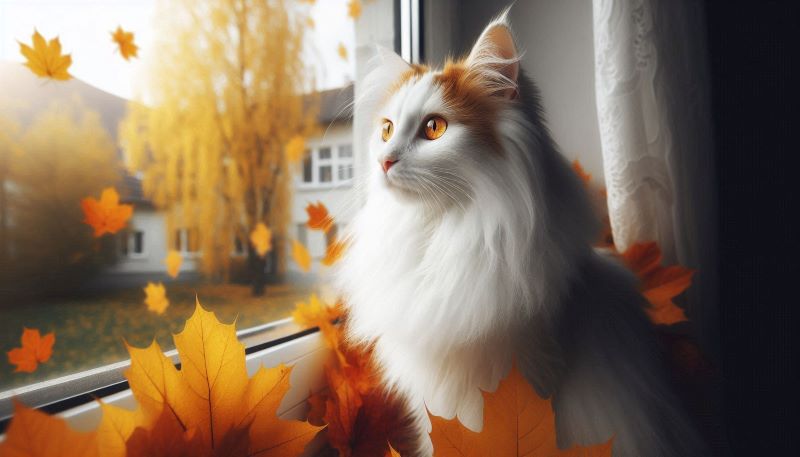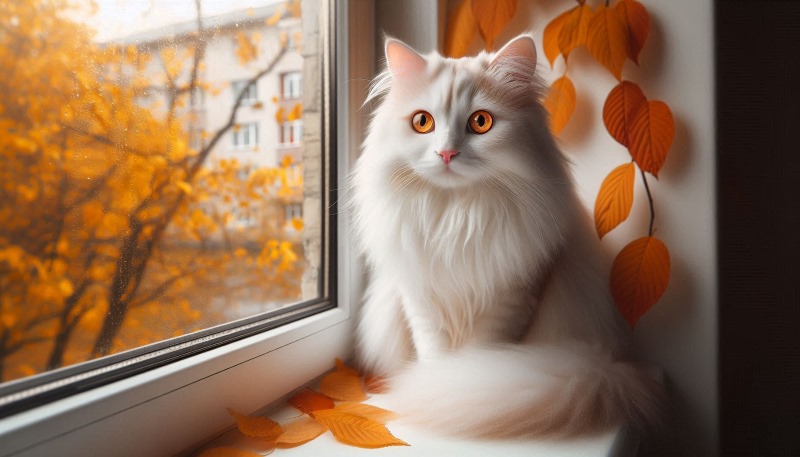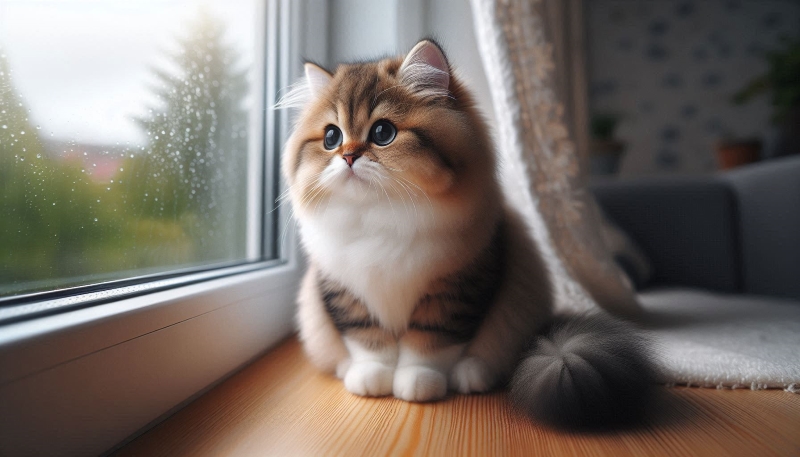The Turkish Van cat breed is a unique and ancient cat breed known for its striking appearance, energetic personality, and unusual love for water. Originating from the Lake Van region in Turkey, this rare breed has captured the hearts of cat enthusiasts around the world.
With a distinctive “Van pattern” of white fur accented by colored markings on the head and tail, and often mesmerizing eyes of different colors, the Turkish Van is as captivating in looks as it is in behavior.
Whether you’re seeking a playful companion or simply intrigued by its fascinating history, the Turkish Van is truly a one-of-a-kind feline.
Turkish Van Cat Breed Information
1. History
The Turkish Van is a rare and ancient breed with a rich history that dates back to the Lake Van region of Turkey. This breed is believed to have existed for thousands of years, with records suggesting they were companions to the people of the area as far back as the Middle Ages.
The breed’s distinctive swimming ability is thought to have developed due to their proximity to water in the region.
Also read: How Many Cat Breeds in The World?
2. Name History
The name “Turkish Van” reflects both the breed’s origin and its connection to Lake Van in Turkey. The word “Van” in the breed’s name specifically denotes the region from which these cats hail.
Interestingly, the Turkish Van is also known as the “swimming cat” due to its unusual love for water, which further distinguishes it from other breeds.
3. Appearance
The Turkish Van is a medium to large-sized cat, known for its robust and muscular build. They have a semi-longhaired coat that is uniquely soft and water-resistant, allowing them to swim with ease.
One of the most striking features of the Turkish Van is its color pattern, often referred to as “Van pattern.” This typically involves a white body with colored markings, usually red, on the head and tail.
The eyes can be blue, amber, or odd-eyed (one of each color).
4. Temperament and Personality
The Turkish Van is known for its active and playful personality. These cats are highly intelligent, curious, and have a strong desire to explore their surroundings.
Unlike many other cat breeds, the Turkish Van is often described as dog-like in its behavior, forming strong bonds with its owners and enjoying interactive play.
They are affectionate but also independent, making them well-suited for families who can engage with their energetic nature.
5. Training and Behavior
Training a Turkish Van can be a rewarding experience due to their intelligence and curiosity. These cats can learn tricks, fetch toys, and even walk on a leash with the right training.
They are known to be quick learners but may also exhibit stubbornness at times. Positive reinforcement is key when training a Turkish Van, as they respond well to treats and praise.
6. Grooming Needs
Despite their semi-longhair, Turkish Vans have relatively low grooming needs. Their unique coat lacks an undercoat, making it less prone to matting and shedding.
Regular brushing once or twice a week is usually sufficient to keep their coat in good condition. Bathing is rarely necessary unless they get into something dirty, as their water-resistant coat tends to stay clean.

7. Exercise Requirements
Turkish Vans are energetic cats that require regular exercise to stay healthy and happy. They enjoy active play sessions, climbing, and even swimming if given the opportunity.
Providing plenty of toys, scratching posts, and opportunities for climbing will help keep them mentally and physically stimulated.
Interactive toys, such as feather wands or laser pointers, can also be great for engaging their hunting instincts.
8. Living Environment
The Turkish Van is adaptable to various living environments but thrives in a home where they have space to roam and explore.
They do well in both apartments and houses, as long as they have enough mental and physical stimulation.
Given their love for water, some owners may even consider providing a shallow water dish or safe access to a pool for supervised swimming sessions.
Also read: 8 Good Cat Breeds for Apartment Living
9. Food
A balanced and nutritious diet is crucial for the Turkish Van’s overall health. They should be fed high-quality cat food that meets their specific dietary needs.
Some Turkish Vans may have a preference for wet food, which can be beneficial for their hydration. It’s important to monitor their weight, as these active cats can easily become overweight if overfed.
Consult with a veterinarian to determine the best feeding schedule and portion sizes for your Turkish Van.
10. Health
Turkish Vans are generally healthy cats with a lifespan of around 12 to 17 years. However, like all breeds, they can be prone to certain health issues.
Regular veterinary check-ups are essential to monitor their health and catch any potential problems early.
Maintaining a healthy diet, ensuring regular exercise, and keeping up with vaccinations and parasite control are key to keeping your Turkish Van in optimal health.
11. Common Health Issues
While Turkish Vans are typically healthy, they may be predisposed to a few specific health issues. These can include hypertrophic cardiomyopathy (HCM), a common heart condition in cats, and polycystic kidney disease (PKD). Regular screenings and early detection are vital to managing these conditions.
Additionally, because they love to swim, care should be taken to ensure they are not exposed to cold water, which could lead to respiratory issues.
12. Lifespan
With proper care, a Turkish Van can live a long and healthy life, often reaching 12 to 17 years of age. Some Turkish Vans have been known to live even longer, particularly when provided with excellent care, a balanced diet, and regular veterinary attention.
Their relatively robust health and active lifestyle contribute to their longevity.
13. Compatibility with Other Pets
Turkish Vans are generally friendly and can get along well with other pets, including dogs and other cats, especially if they are introduced properly. Their playful and social nature allows them to adapt to multi-pet households.
However, their high energy levels and desire for attention mean they may not tolerate being ignored or left out of the action.
14. Breed Standards and Recognition
The Turkish Van is recognized by major cat associations such as The International Cat Association (TICA) and the Cat Fanciers’ Association (CFA).
To meet breed standards, Turkish Vans should have the characteristic “Van pattern” with a predominantly white body and color only on the head and tail.
The breed standard also emphasizes their muscular build, large size, and unique eye colors.
15. Famous Examples
The Turkish Van has captured the attention of cat lovers worldwide, including a few notable examples in popular culture. While there aren’t many famous Turkish Vans, the breed’s unique traits have made them a favorite in cat shows and among enthusiasts.
Their reputation as “swimming cats” has also made them the subject of various media features and documentaries.
16. Adoption vs. Breeders
When considering adding a Turkish Van to your family, you have two primary options: adoption or purchasing from a breeder. Adopting from a shelter or rescue organization can be a rewarding experience, as you are giving a cat a second chance at life.
However, Turkish Vans are rare in shelters, so finding one might be a challenge. Purchasing from a reputable breeder ensures you know the cat’s lineage and health history, but it can be more expensive.
17. Where to Get It
Finding a Turkish Van can be more challenging than other breeds due to their rarity. Reputable breeders specializing in Turkish Vans are the most common source. It’s important to research breeders thoroughly, ensuring they follow ethical practices and provide healthy, well-socialized kittens.
Alternatively, you can check with breed-specific rescue organizations or attend cat shows where Turkish Vans may be featured.
18. Price
The price of a Turkish Van can vary depending on factors such as lineage, breeder reputation, and location. On average, you can expect to pay between $400 to $1,500 for a Turkish Van kitten from a reputable breeder.
Cats from champion bloodlines or those with rare color patterns may command higher prices. In addition to the purchase price, consider ongoing costs such as food, grooming, and veterinary care.
19. Cost of Ownership
Owning a Turkish Van involves more than just the initial purchase price. Ongoing costs include high-quality food, regular grooming supplies, toys, and routine veterinary care.
Additionally, you may need to invest in interactive toys and climbing structures to keep your Turkish Van entertained. Budgeting for potential health issues, especially as the cat ages, is also essential.
20. Legal Considerations
There are typically no specific legal restrictions on owning a Turkish Van, but it’s important to check your local regulations, especially if you plan to breed or sell them. Some areas may require pet registration or have specific laws regarding the keeping of exotic or rare breeds.
If you’re importing a Turkish Van from another country, ensure you follow all necessary import and vaccination requirements.
21. Socialization Tips
Early socialization is key to raising a well-adjusted Turkish Van. Start by introducing them to various environments, people, and other pets gradually. Use positive reinforcement to create positive associations with new experiences.
Because they are naturally curious and confident, Turkish Vans usually adapt well to socialization, making them friendly and outgoing companions.
22. Nutritional Needs
A balanced diet is crucial for the Turkish Van’s overall health and well-being. High-quality commercial cat food that meets AAFCO standards is recommended. You might consider a mix of dry and wet food to ensure they get the right balance of nutrients and hydration.
Because of their active nature, Turkish Vans may require a slightly higher calorie intake, but be cautious to avoid overfeeding, as obesity can lead to health issues.
23. Breeding Considerations
If you’re considering breeding Turkish Vans, it’s important to have a thorough understanding of their genetic history and potential health risks. Breeding should only be done by experienced individuals who are committed to maintaining the breed’s standards and health.
Ensure that both the male and female are healthy, free of genetic disorders, and meet the breed standard. Responsible breeding also involves finding good homes for kittens and ensuring they are well-socialized before they leave for their new families.
FAQ on Turkish Van Cat Breed
Is a Turkish Van a rare cat?
Yes, the Turkish Van is considered a rare cat breed. Originating from the Lake Van region of Turkey, they are not as commonly found as other breeds, making them unique and highly sought after by cat enthusiasts.
How do I know if my cat is a Turkish Van?
To identify a Turkish Van, look for a white coat with colored markings on the head and tail, often combined with large, muscular build and either blue, amber, or odd-colored eyes. Their love for water is also a distinguishing trait.
Are Turkish Van cats talkative?
Yes, Turkish Van cats are known to be talkative. They enjoy communicating with their owners through a range of vocalizations and are often quite expressive in their interactions.
Are Turkish Van cats aggressive?
Turkish Van cats are generally not aggressive. They are playful, energetic, and affectionate, though they can be assertive when they want attention. Proper socialization helps ensure they are friendly and well-behaved.
What does Turkish Van eat?
Turkish Vans should be fed high-quality commercial cat food that meets their nutritional needs. A balanced diet of dry and wet food is recommended, and they may have slightly higher calorie needs due to their active nature.
His professional interests include humane education, ethics, small animal behavior, and veterinary. As a pet lover from school life, having grown up with two cats and a dog. If he isn’t spending time with his friends and family, Justin enjoys traveling. Learn more about Justin here.


